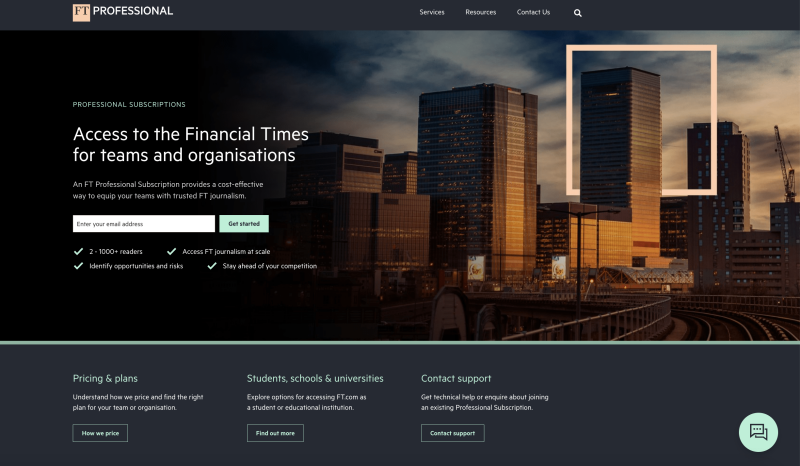
The Financial Times is targeting growth in its B2B division with a bolstering of its offering so it acts as “more than a newspaper” for business and student subscribers.
Currently FT Enterprise sees almost 8,000 businesses, government and education institutions in 120 countries pay for their teams to have a group subscription providing full access to FT journalism alongside some exclusive tools.
The B2B division, which formally launched in 2007, makes up three-quarters of the FT’s paying readership and its revenue has grown at an average of more than 10% each year since 2018, according to the company.
In total across its consumer and B2B divisions the FT has 1.2 million paying readers, more than one million of which are digital.
The rebrand to FT Professional will see it target growth industries of professional services, law, media and tech alongside its existing core sectors of financial services, banking, government and education.
FT Professional will also see the number of exclusive features for B2B subscribers increase. So far this year it has added the ability for subscribers to share FT articles for free with colleagues and clients, integrated the FT app into Microsoft Teams, and created tools for personalised content recommendations and highlighting or saving key points from articles.
Nick Fallon, managing director of FT Professional, said: “Now is the time to clearly articulate how we are different and how we add value to subscribers over and above just reading a newspaper, helping them address specific business challenges and outcomes.
“Over the last decade, we’ve seen increasing demand from subscribers who use the FT to work or study. We know that FT Professional subscribers feel more equipped to do their job well or make informed decisions in the workplace. Readers who use new professional features visit ft.com three times more often and engage with 50% more content than average.”

There is also a visual rebrand, with the addition of a mint green colour palette to contrast with the newspaper’s iconic pink (which this year marks its 130th anniversary on the FT’s pages) and further differentiate the offering from the standard consumer subscription.
The relaunch will also be accompanied by a marketing campaign over the rest of 2023, including paid ads and search and paid and organic social media, with different messaging for businesses and government organisations versus educational institutions.
FT Professional marketing director Roz Sedgwick said the division “makes up a significant part of the FT’s audience” and the rebrand “will allow us to communicate with that audience with clarity and build awareness of the FT Professional brand over time”.
The FT’s group subscriptions can be priced based on an organisation providing access to a certain number of people, to everyone, or it can depend on how many “core” readers they have – defined as those who read nine or more articles in any 30-day period – as well as a number of “occasional” readers.
In 2023 a “core” reader could cost an organisation £471 for the year in a small organisation or £323 in a much larger one. A standard FT digital subscription aimed at a single consumer costs £335, or £525 for the premium option.
Email pged@pressgazette.co.uk to point out mistakes, provide story tips or send in a letter for publication on our "Letters Page" blog
